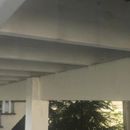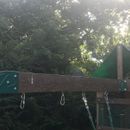Supporting Slack-Line Obstacle Course
Hey hope all is well. My 4 year old wants monkey bars, they sell a slack line like this https://www.amazon.com/Rainbow-Craft-Slackline-Accessories-Equipment/dp/B09PQ9DNL4/ref=sxin_19_pa_sp_phone_search_thematic_sspa?content-id=amzn1.sym.707693a7-0d1e-4cb0-960c-55bd57be6bd4:amzn1.sym.707693a7-0d1e-4cb0-960c-55bd57be6bd4&crid=2WRHAMNGJMJ38&cv_ct_cx=ninja+warrior+obstacle+course+for+kids+30+feet&keywords=ninja+warrior+obstacle+course+for+kids+30+feet&pd_rd_i=B09PQ9DNL4&pd_rd_r=2beb8a3f-c883-4d53-b036-887d4c5a0e51&pd_rd_w=h1HYu&pd_rd_wg=8ccDe&pf_rd_p=707693a7-0d1e-4cb0-960c-55bd57be6bd4&pf_rd_r=NK18QWQRZPK0CPPP0QKR&qid=1659476682&sprefix=ninja+warrior+obstacle+course+for+kids+3,aps,1262&sr=1-2-a73d1c8c-2fd2-4f19-aa41-2df022bcb241-spons&psc=1
However I don’t have two trees. I was thinking about hooking one end to my deck beam and the other to either a swing set or somehow use the garage wall with an ibolt. I would think the garage can support the weight more than a swing set. The swing set is not posted in concrete. Any solution on how to attach it the the garage.
GBA Detail Library
A collection of one thousand construction details organized by climate and house part











Replies
I would not use that swing set as an end support. You can generate surprisingly high tension forces in that rope line in a setup like this (it’s actually easy to calculate, this is a vector problem that needs only basic trigonometry). The tighter you pull that top rope at install time, the higher the forces exerted on the support structure will be when your child is hanging on it.
I’d actually be reluctant to attach this to a garage wall too, but if you do, you want a welded eye bolt, not an open type, and you want to bolt it all the way through the wall into a 2x6 spanning at least two studs and the top plate too for maximum strength. Do not trust a lag screw style eye bolt here. Remember that if the anchors pull out while your child is playing, the ends of the top will whip out towards your child.
What I would do is build some “trees” specifically to support the rope. Use a 4x4 post on either end, with the bottom end set in the ground about 18” to two feet. Use screw-in earth anchors like these:
https://www.tractorsupply.com/tsc/product/harvest-48-in-l-earth-anchor-with-6-in-dia-auger?cm_vc=-10005
Place two anchors on the opposite side of each end post from where the rope attaches, and space them about 60 degrees apart and about as far out from the base of the post as the post is tall. Use a closed eye bolt all the way through the post with an eye bracket on the opposite side under the nut. Cable that bracket to each of the two earth anchors. This way the bolt and earth anchors take all the tension and the post only holds things up vertically.
Note that all the fancy hardware you need is known in the utility world as “pole line hardware” and is readily available by mail order, and maybe from your local power company too if you ask nicely at one of their service yards. Pole line hardware is strong, and it’s galvanized for outdoor use. Just don’t make fun of our square head bolts and nuts. We like our square head bolts and nuts :-)
Bill
All of my slackline experience has been between two trees. However, as I understand it when one is in a field, one makes ground anchors, and elevates the line with A-frames.
https://www.outlandusa.com/p/gibbon-slacklines-ground-screw-70?utm_source=google_shopping&utm_medium=cpc&utm_term=&campaign_id=14382065659&adgroup=125707747345&matchtype=&device=m&devicemodel=&placement=&adposition=&gclid=CjwKCAjwlqOXBhBqEiwA-hhitMIg2j5NajB9T_GNXyofWBNq8od0wTXFCGPcDOie7mzKIp36YrSFHhoCBUMQAvD_BwE
Hope this helps,
Ben
Edit- just read the suggestion above, very interesting how similar our replies are
"Slackline" in the title is misleading. Most people think of slacklines like the Gibbon product referenced by Ben. For beginners, mounting them low (eg, 9" off the ground) is much safer.
Regarding the Rainbow craft product that was linked, Bill rightly points out that pulling sideways on an almost straight cable generates huge force multipliers. Careful.
user...575,
" Bill rightly points out that pulling sideways on an almost straight cable generates huge force multipliers. Careful."
A retired logger set up slack-lines to help move these D.Fir beams for me. Amazing the forces you can generate. if you walk through the forest here you can find marks on large standing trees where cables from slack-lines bit into them.
I just did a quick search for indoor slackline setups, as one could be brought outdoors when needed. It appears that there are commercial options costing up to 500$, though people build their own. I agree with the above comments about how the forces generated are surprisingly high, but for kids use I feel as though a homemade option would be feasible.
https://m.youtube.com/watch?v=nEbNpIbgkh4
Hope this helps,
Ben
You CAN build your own setup, but you need to BE SURE it's SAFE. Just because it's "for the kids" doesn't mean it doesn't need to be safe. Many would probably want something for their kids to be MORE safe.
The most important things are that the top rope is strong enough, and it needs to be much stronger than you might think, and the anchors need to be secure so that there is no risk of them pulling out. This is why I like through-bolted setups that don't rely on the wood to handle tension forces. If you look at any utility pole, you'll see that ALL guys and supported cabling are assembled this way, nothing relies on the wood itself to hold any kind of screw, everything goes all the way through the pole where it is secure on the opposite side with a nut and washer.
I can't stress enough how important it is to build things like this safely. You can have someone get really hurt if the rope snaps or an anchor lets go, because all the forces involved make the cable whip back at the kid that was playing on the line. That's in addition to the risk of the kid falling onto the ground in some oddball position and getting hurt that way too.
Just to make a point about the forces involved, if you put together the vector problem to mathematically work out the forces involved, and you put a weight (a hanging kid) in the middle of the rope, with the rope supported on either end, you find that as the rope is pulled towards a horizontal line, the tension in the rope aproaches infinity -- meaning INFINITE force. Obviously that's not possible in reality, but it gives you an idea of how high those forces can theoretically get. If you leave the rope a bit more slack, the tensile forces are greatly reduced.
Bill
Here’s a calculator of the forces involved
https://www.bergfreunde.eu/slackline-forces-calculator/
Thanks for all the replies, looks like it’s possible to create my own setup but I should be very worried about safety. I looked In my front yard today I have a lily tree I believe with a street utility pole about 25 feet away. Not sure if I can use the utility pole and the truck of the tree is short before it branches off. Not sure if the branch off can handle the weight or if you can use a utility pole for this setup. I also saw another setup that uses a double line, would that decrease the amount of pressure since it is split between two lines and therefore be safer? https://www.amazon.com/Ninja-Slackline-Obstacle-Course-Kids/dp/B07YX8YJHT?ref_=ast_sto_dp&th=1&psc=1#video-immersive-view_1659574807852
Again if it still is risky maybe I should stick to building traditional wooden monkey bars that don’t rely on a rope under tension
No, you can’t use the utility pole unless you own it. There should be a metal tag attached to the pole, usually a round tag with a single nail in the middle, that will tell you who owns the pole if it’s owned by a utility company. Chances are it’s not a private “yard pole” though if you’re on a city lot. I would assume it’s a utility-owned pole though, in which case you can’t attach to it.
Note that utility contractors can set poles for you. The utility company service yard can help you find such a contractor. Poles are surprisingly expensive though, so you’d be better off with 4x4 posts. If you use a 4x4, it’s nice to router the corners with a 3/8” or 1/2” roundover bit to make them smoother and less likely to scrape your child while they’re playing.
Bill
So I found these plans online for monkey bars, anyone see anything dangerous about the design. It’s not set in concrete. I was thinking about adding 4 ground anchors to secure it, that’s how my swing set is set up to, ground anchors no cement. https://myoutdoorplans.com/playhouse/monkey-bar-plans/
It doesn't look bad to me, although one of the example projects shows the ladder rungs sticking out past the sides of the posts. I would not leave anything sticking out like that, since the ends then become things that could snag someone if they fall. Try to avoid any "sticking out" parts that could end up being a hard thing to hit while falling.
I'd also router all the edges with a large radius roundover bit, which will make everything much smoother and less likely to hurt you.
Bill
Long ago, when my kids were in elementary school, the playground had monkey bars like that, but set in concrete. One day I was chatting with the principal and he off-handedly remarked that every year a kid broke their arm on the monkey bars. When the playground was renovated a few years later they got rid of them.
If you google a bit you'll see that monkey bars are highly controversial, with some pediatricians feeling they should be banned and some parents feeling that children shouldn't be overprotected.
I'll offer my layman's opinion, which is the monkey bars in the picture are high enough that a child the age of the one in the picture could be injured in a fall. They don't need to be that high, the child has to climb up three steps to get on. They're just as fun for the kid if their feet are only a few inches off the ground, and a lot safer. I would build them so that there's only one step to get up, about six inches off the ground, and the bars are adjustable in height so that the child who will be using them can stretch and grab the first bar from that step. Obviously this doesn't work if kids of different sizes are going to be using them.
The plans look like they have a second set of bars for older kids, which I like better than having everyone swing at the same height. But-but-but --- You want to build it so that if someone gets on top and falls through they fall all the way through, you don't want any openings that are small enough to trap them if they fall in, they could suffocate or strangle.
The basic rack in the plans looks strong enough to support a slackline with ground anchors. I think that might be an easier way to adjust it to a safe height.
I have been researching monkey bars and came across that they are considered the most dangerous of playground equipment. Like DC pointed out many have broken their arm. After reading, my plan was to cut the frame shorter so that the monkey bars would hang at 60 inches. The recommended max for elementary kids. DC’s suggestion of only using one ladder rung 6 inches off the ground would be closer to a 4 foot height which is even safer. Looking at the plans, the last step is to attach the ladder part. I could keep the same basic frame of 88” and just attach it lower. Not sure if that affects the whole strength of the structure. Attaching the ladder is the confusing part to me I see. Is it just held up by screws in the 2x4 posts. Could I simply unscrew it and move it up as the kids grow? I don’t know if I will even keep this long term but it’s nice to have the option to adjust it. The slack line idea is turning me off because basically your kid is hanging on a wire that is creating incredible forces. Maybe I can convince my kids monkey bars are too dangerous, but it would be nice to make them happy and make the monkey bars safer than playground